Blog

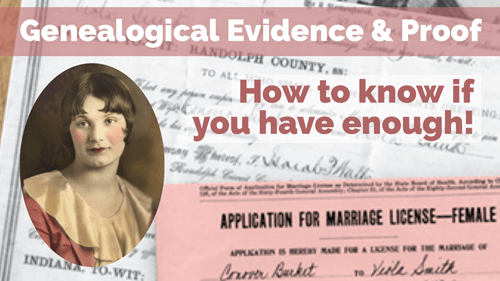
Genealogical Evidence and Proof: How to know if you’ve compiled enough evidence
The Genealogical Proof Standard tells us that we need to conduct reasonably exhaustive research in order for our work to be credible. If you’ve ever wondered just what constitutes “reasonable” (and if your family tree is up to snuff) my guest author Kate Eakman, professional genealogist at Legacy Tree Genealogists, has answers.
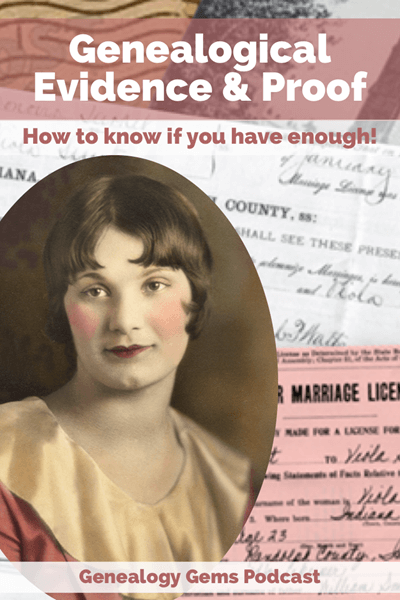
Professional Genealogist Kate Eakman explains evidence on the Genealogy Gems blog.
Genealogical Evidence: Have You Got What It Takes?
How do we know when we have compiled enough evidence to constitute proof?
Is a birth certificate or an autosomal DNA test result sufficient to declare this person is the child of that person?
Must we collect every record regarding an individual – the deeds, the tax lists, the newspaper clippings, the census reports – before we can declare a familial connection?
The Genealogical Proof Standard (GPS)
The Genealogy Proof Standard (GPS) directs us to perform reasonably exhaustive research, which requires that we identify and review all available records related to an individual.[1] This is being as thorough and accurate as possible and is a goal toward which we should all aspire in our genealogical research.
But, let’s be honest: most of us do not want to spend weeks or months (or even years) documenting one person before moving on to the next individual. We don’t want to know every detail of grandpa’s life before we turn to grandma.
We want to build a family tree which accurately provides us with the names of our ancestors so that we can identify our immigrant ancestor, or join a lineage society, or enjoy the satisfaction that comes from a balanced tree extending back a hundred years or more.
We want to be thorough and accurate, but we also want to make some progress. How do we balance the need for accuracy with the desire for results? How do we determine the necessary quality and quantity of evidence for our research?
Below are some guidelines to demonstrate how we can go about compiling the necessary information to say with confidence “this person is my ancestor.”
Genealogical Evidence Guidelines
1. One record/source is never enough.
Any one piece of data can say anything. A mother might lie on her child’s birth certificate for a number of reasons. A grieving spouse might not correctly recall the information for a husband or wife’s death certificate. There are typos and omissions and messy handwriting with which to contend. Even a lone DNA test is not sufficient evidence to prove a family connection.
We need multiple sources, and different kinds of sources, which corroborate the details of the others.

A single source is not enough. A marriage license does not guarantee that John and Griselda married. Photo courtesy https://newspapers.com.
A census report and autosomal DNA test results.
A deed and a will.
A birth certificate and an obituary.
Or, better still, a birth certificate, a census report, a deed, a will, an obituary, and autosomal DNA test results.
2. The more contemporary the source is to the person or event in question, the better.
Records of events made immediately after the event tend to be more accurate, and provide better details, than records created months or years later. As time passes, details become fuzzy, two events can be confused with each other, and our memories fade.
The passage of time between an event and the record of the event also allows for some revisionist history to creep in.
Here are some examples:
A birth year is adjusted to make someone appear older or younger in order to avoid the draft, enlist in the military, mask a dramatic age difference between spouses, or conceal an out-of-wedlock birth.
An obituary ignores the deceased’s first marriage because of some embarrassment associated with that marriage.
A census report enumerates everyone in the household as natives of Stepney, London, when they really were born in Stepney, and Hackney, and Whitechapel, which explains why the baptismal records can’t be found in Stepney.
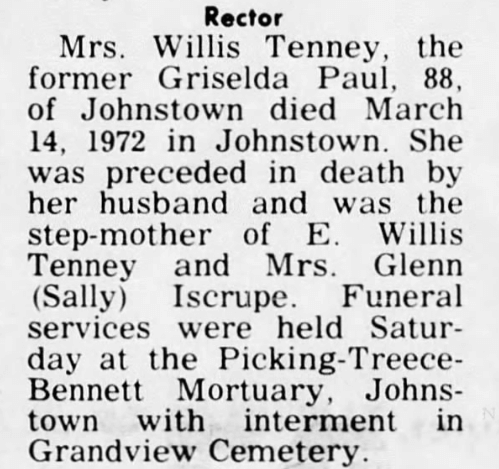
According to this obituary for Griselda, she was the widow of Willis Tenney, not John Wise. It appears Griselda and John did not marry after all. Photo courtesy https://newspapers.com.
According to this obituary for Griselda, she was the widow of Willis Tenney, not John Wise. It appears Griselda and John did not marry after all. Photo courtesy https://newspapers.com.
This is particularly true when it comes to autosomal DNA testing. My autosomal DNA is more useful for identifying my ancestors than is my son’s because I am one generation closer to those ancestors. This is the reason we encourage people to test the oldest members of their family first: their DNA has the potential to be the most useful simply because they are from an earlier generation (or two).
3. It is okay to make appropriate assumptions, but be careful!
In genealogical research we must sometimes make assumptions. When research theories are based on logical reasoning, it is perfectly acceptable to make those appropriate suppositions.
Determining which assumptions are appropriate can be simple: the two-year-old child enumerated in the home of a 90-year-old woman in the 1850 census can safely be eliminated as a biological child of that woman; the man born in 1745 could not have been buried in 1739; the person with whom I share 3150 cM of DNA is my sibling.
The challenge is to avoid making what seems like an appropriate assumption but is really based on faulty reasoning or bias. For instance, we presume that every child listed in a household in the 1860 U.S. Census is son or daughter of the two adults listed first. However, the household could include step-children, cousins, or individuals not even related to the family who were erroneously assigned the same surname.
Other inappropriate assumptions can include:
- the notion that a baby was born within a week of his baptismal date;
- a woman’s reported surname on her marriage certificate is her maiden name;
- there is only one person in any village, town, or city with the name of your ancestor;
- someone who shares 2000 cM of DNA with you must be your grandparent, aunt or uncle, niece or nephew, half sibling, or grandchild (they could be a ¾ sibling, the child of one of your parents and the sibling of the other parent).
4. All of the data from the various sources must correlate, and there can be no unresolved contradictions.
When the birth certificate says Richard was born in 1914, the 1938 newspaper article about his wedding reports Richard was 24 years old and the 1942 World War II Draft Registration card notes Richard’s date of birth occurred in 1914, we can confidently declare Richard was born in 1914.
If the wedding article declared the groom was 23 years old the contradiction could be explained by the time of year in which the wedding occurred – before or after Richard’s birthday.
But if his birth certificate reported a 1914 birth, and the newspaper article noted Richard was 32 years old, while the World War II Draft Registration listed his year of birth as 1920, we have some important contradictions. It is most likely the records are for three different men with the same name.
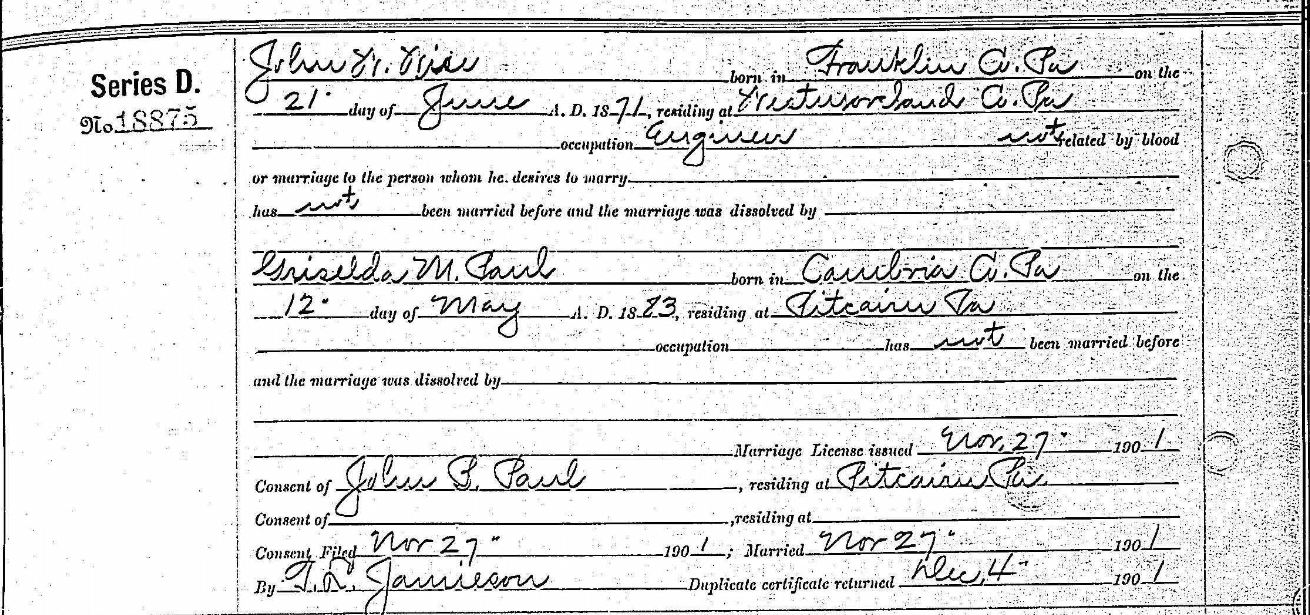
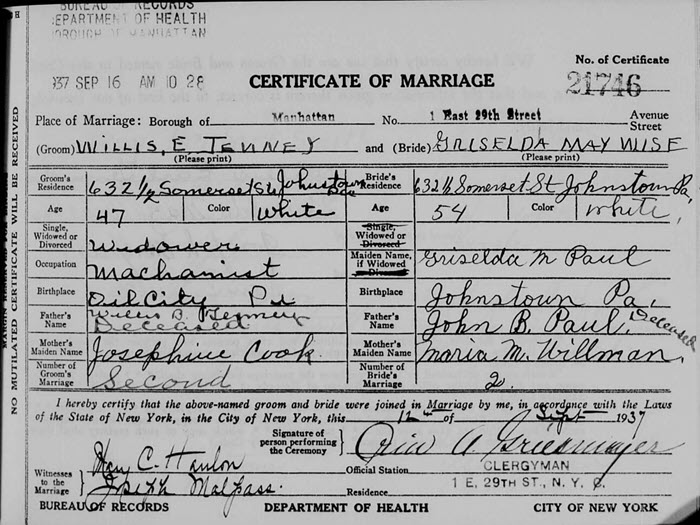
By collecting additional evidence, we finally learn that Griselda and John Wise did marry, and after his death Griselda married Willis Tenney. If we had collected only one of these four records we would not have had the most accurate information regarding Griselda Paul. Photos courtesy https://familysearch.org.
It’s important to remember that once we have accomplished that initial goal of building out our tree a few generations (or identifying our immigrant ancestor, or determining if we are related to that historical person) we can – and should – go back and collect other sources related to that person. This will result in uncovering a more complete story of their lives in the process.
As we can see from the four documents regarding Griselda Paul’s marriages, her story is much more than a simple list of birth, marriage, and death dates. As we identify, review, and analyze the other available sources, Griselda’s story will come alive with the facts and details we uncover.
A Fresh Set of Eyes on Your Genealogy Brick Wall
Sometimes the wrong evidence or assumptions can push us into a brick wall. A fresh set of expert eyes can help you identify the problem, and recommend the sources you need to pursue in order to compile trustworthy evidence.
If you are looking for some assistance in your genealogical research, Legacy Tree Genealogists can help. Our affordable ($100 USD) Genealogist-on-DemandTM Virtual Consultation service provides you with the opportunity for a 45 minute one-on-one discussion of your research with one of our expert genealogists. We can help guide you in evaluating evidence and determining research strategies to move forward with your research confidently.
About the Author: Kate Eckman
Legacy Tree guest blogger Kate Eakman grew up hearing Civil War stories at her father’s knee and fell in love with history and genealogy at an early age. With a master’s degree in history and over 20 years experience as a genealogist, Kate has worked her magic on hundreds of family trees and narratives.
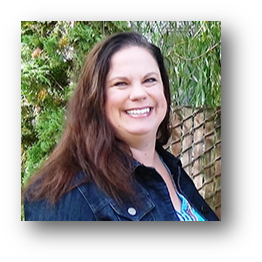
Professional Genealogists Kate Eakman
[1] “Genealogical Proof Standard (GPS),” Board for Certification of Genealogists, https://bcgcertification.org/ethics-standards, accessed March 2020.

Episode 1 Elevenses with Lisa Show Show Notes – Family History Show
Live show air date: March 26, 2020
Episode 1 Video and Show Notes
(UPDATED April 14, 2020 to reflect the show is moving from Facebook to YouTube LIVE)
What’s even better than listening to a genealogy podcast? Watching and listening to a genealogy online show! Elevenses with Lisa is the new online video series by author and international genealogy speaker and host of The Genealogy Gems Podcast, Lisa Louise Cooke. In this article you’ll learn what the show is about, how to watch live and how to watch the replay videos, how to set up reminders so you don’t miss an episode, and an easy way to share it with your friends so they can watch with you.
A New Online Show About Genealogy and Family History
As my world, like yours, started getting physically smaller last month, I became determined to branch out in different ways. I started by making a list of things I’ve always wanted to do but haven’t. Some of them I had felt a little intimidated by, and some had fallen prey to a lack of time. So, it felt great this week to take one head on and give it my best shot.
And that’s how Elevenses with Lisa, a LIVE online show, came to be.
I tried one or two quick Facebook LIVE’s several years ago. Back then the system seemed unreliable and a bit frustrating. Revisiting it this week I discovered it is more complex on the back end, and yet far more stable. In addition to forcing myself to sit down and really figure it out, I also took on learning a new software program that would bring the production-values I felt you deserved.
The Show is Available on YouTube (Live & Video)
After the third episode I decided to move the show from Facebook to YouTube. It makes more sense for a variety of reasons, the main ones being that the Genealogy Gems YouTube channel is already very well established, and an account is not required to watch. (That being said, signing into YouTube with your free Google account will make it even easier to follow the show and receive notifications of new episodes. More on that below.)
Elevenses is a lovely traditional short morning tea break, and we make it sweeter by adding genealogy.
It all came together very quickly and on Thursday March 26, 2020 many of you joined me live. If you missed it click the video above to watch it on the Genealogy Gems YouTube channel or click the video above.
Elevenses with Lisa is a 30 minute break to check in with each other and chat about genealogy. In this show I share some of my favorite tips and tools that I use while Googling for family history.
Amazingly it came off without a hitch, and candidly I had a blast!
In episode 1 I asked you if you’d like to see more in this series, and your responses have warmed my heart!
After watching the show on YouTube Tracey commented: Thank you so much for this Lisa! I would love to see anything that you would like to share with us. I find your work to be incredibly helpful and I just love listening to you – it’s like you’re an old friend. Your tips make me look like a genius which I also appreciate!!! Thank you 💛
Mark Your Calendar for “Elevenses with Lisa” (Live on YouTube)
Episodes will air live on Thursdays at 11:00 AM Central on the Genealogy Gems YouTube channel. Mark your calendars!
If you use Google Calendar, set it up once for this Thursday, and then change it to “Weekly”. (Image 1) You can also set notifications to remind you just before the show starts. Select email, “notification” (which will pop up in your web browser), or both!
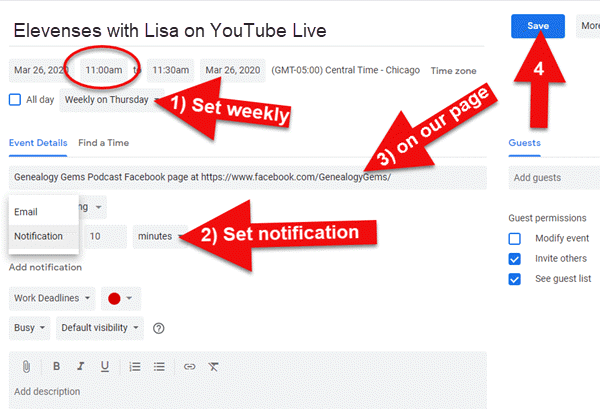
Image 1 – Set your Google calendar for Elevenses with Lisa
How to Tune In to the Live Show
If Youtube is new to you, joining me for the live show might feel like a bit of a stretch. Well, I have good new for you, it’s actually super easy to tune in. Here’s how:
1. Put it on your calendar
Click here to figure out what time 11:00 am Central is in your time zone.
2. Go to the Genealogy Gems YouTube Channel
Click here to go to the Genealogy Gems YouTube channel (or just search “Genealogy Gems” in the YouTube search box.)
Although a YouTube/Google account is not required to watch the show, I strongly recommend signing into YouTube with your free Google account. The reason is that it will allow you to customize what you see to your liking when you visit YouTube, and it will allow you to subscribe to my channel for free and receive notifications of episodes and videos.
If you don’t have a Google account, go to Google.com and click the Sign In button. If you don’t have a Google account you’ll be prompted to create one. Once created, sign into YouTube with that same account. (Image 2)
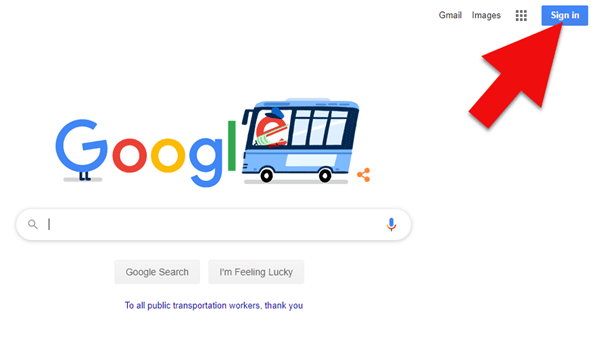
Image 2 – At Google.com click “Sign in” and you will be prompted to sign in with your Google account or set one up.
3. Look for the Live show on my Genealogy Gems YouTube Channel
Another great thing about having the show on YouTube is that I can schedule episodes ahead of time and you can receive reminders to watch.
Now that you’re logged into YouTube, when you arrive at the Genealogy Gems channel you can click the Subscribe button. (Image 3) This will put the Genealogy Gems channel in your list of favorite channels. And that means when you visit YouTube you’ll probably see more about my videos and other genealogy videos, and less about things you’re not interested in.
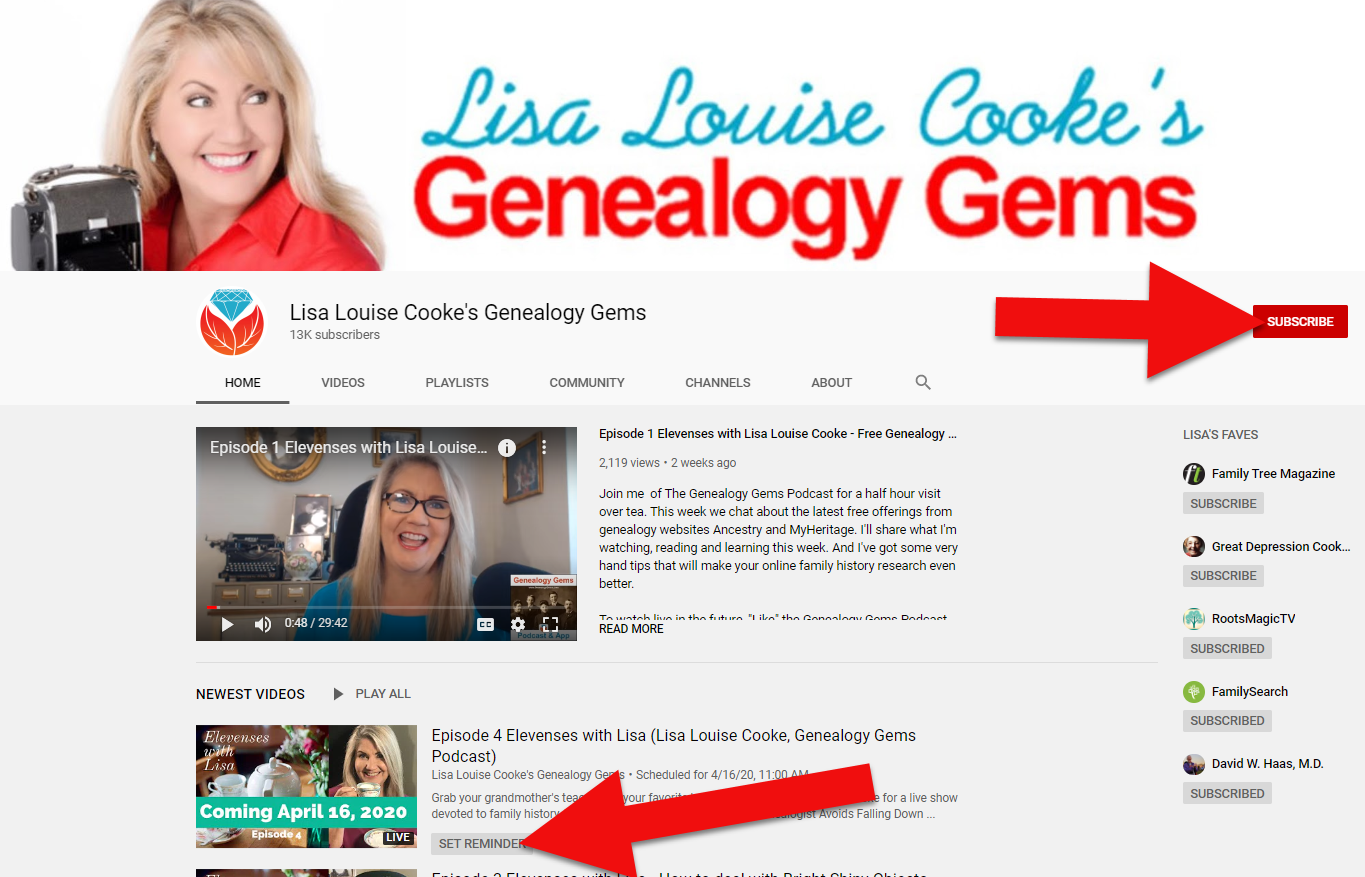
Image 3 – Subscribe and watch at the Genealogy Gems YouTube channel
After you click Subscribe a bell icon will appear. (image 4) Click the bell to receive notifications of new videos I publish on the channel.

Image 4 – Click the bell icon for notifications.
The first video will be my featured video. Below that you’ll find “Newest Videos”. The next scheduled “Elevenses with Lisa” episode will appear at the top of the list of videos. Click the “Set Reminder” button for the episode. (Image 3) This will send you a special notification when the show is about to go live.
4. Come back when we go live.
Click the link in your notification and it will take you back to the live episode on my Genealogy Gems YouTube channel. You will see the introductory image or video with background music until we go live. Then you’ll automatically see the video live stream. If you don’t after 11:00 Central, try refreshing the page.
You don’t have to do anything but have your speakers on. If you don’t hear sound, click the speaker icon in the bottom right corner of the video to turn the sound on.
5. Leave a comment or question
In addition to sharing ideas, I hope to spend some time interacting with you. The video chat is the place to leave your comment or question. Your comments and questions are my favorite part of doing the show!
6. Watch later
If you miss the live broadcast or want to see it again, watch the replay here on my Genealogy Gems YouTube channel (Image 5). The most recent videos appear first.
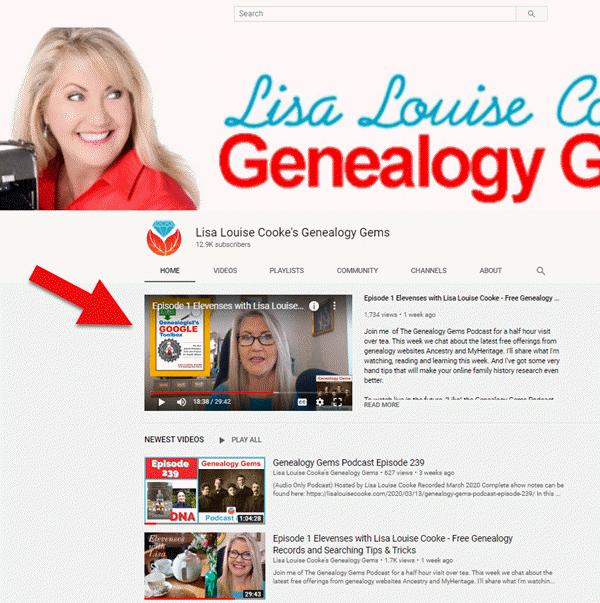
Image 5 – Elevenses with Lisa on the Genealogy Gems YouTube channel
Click the episode to watch. To find all the episodes just click “Playlists” and then click “Elevenses with Lisa” (Image 6):
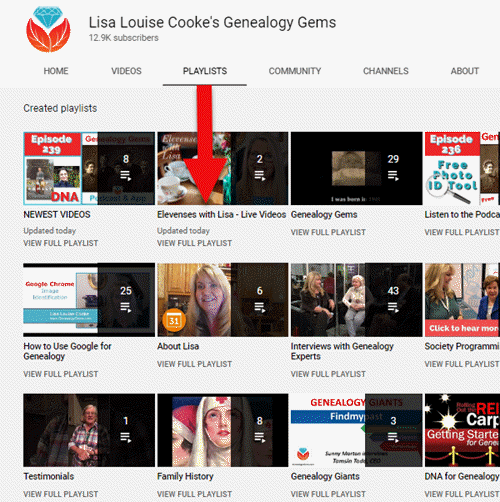
Image 6 – Elevenses with Lisa Playlist
You can leave comments and questions under each video on the Genealogy Gems YouTube channel. It’s your feedback that helps me determine what we’ll talk about and how often to produce the show. If you like it, please be sure to click the “Like” button. Remember, this is a two-way conversation show!
7. Share with Your Friends
Will you please do me a favor and help me get the word out about “Elevenses with Lisa”? If you’re enjoying the show, you are the perfect person to let other family historians know about your find. I’m keeping the show free, so there’s no money for advertising to spread the word. I’m dependent on and grateful for your help! It’s easy – just click “Share” under the next scheduled episode or any previously recorded episode. (Image 7) Sharing is fun because you can visit with your friends as you watch in the Chat area.
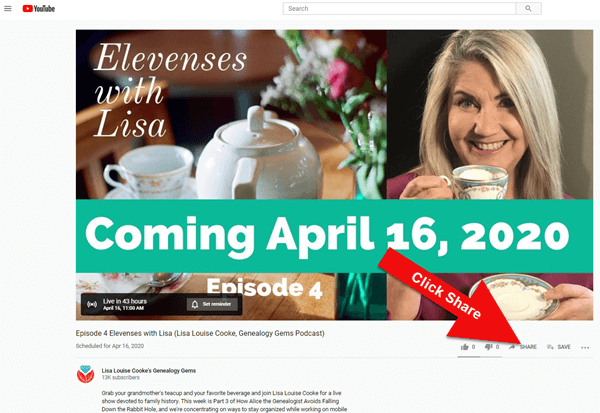
Image 7 – Please share Elevenses with Lisa
You’ll find lots of options for sharing the show. (Image 8)
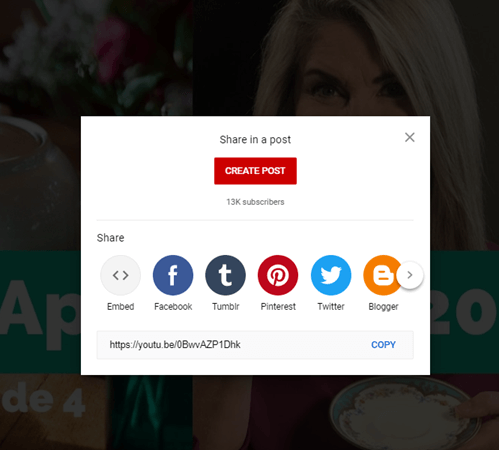
Image 8 – Youtube sharing options.
Everyone likes a good cup of tea (or coffee, or…), a snappy tech tip, and learning ways to be more productive and inspired, right? I hope you’ll consider even sharing “Elevenses with Lisa” with your friends who say they’re not interested in genealogy. You never know, they might just get interested in family history.
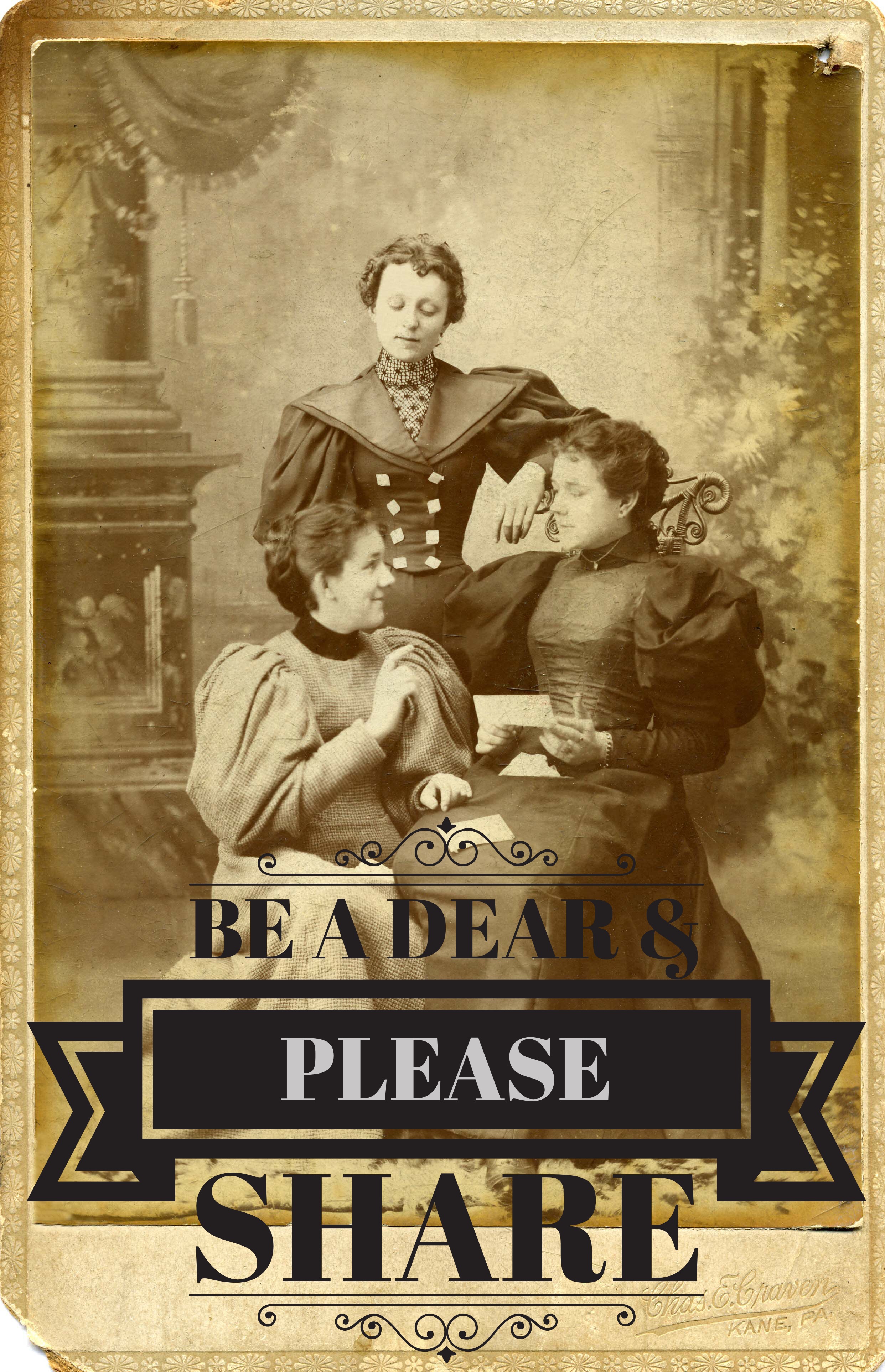
Thank you for sharing Genealogy Gem’s “Elevenses with Lisa”!
Questions or Comments about Elevenses with Lisa?
Being couped up at home doesn’t mean we can’t stretch our wings. Thank you for helping me stretch mine! If you have any questions about how to tune in, or you have a question you’d like me to answer on the show, please leave a comment below.
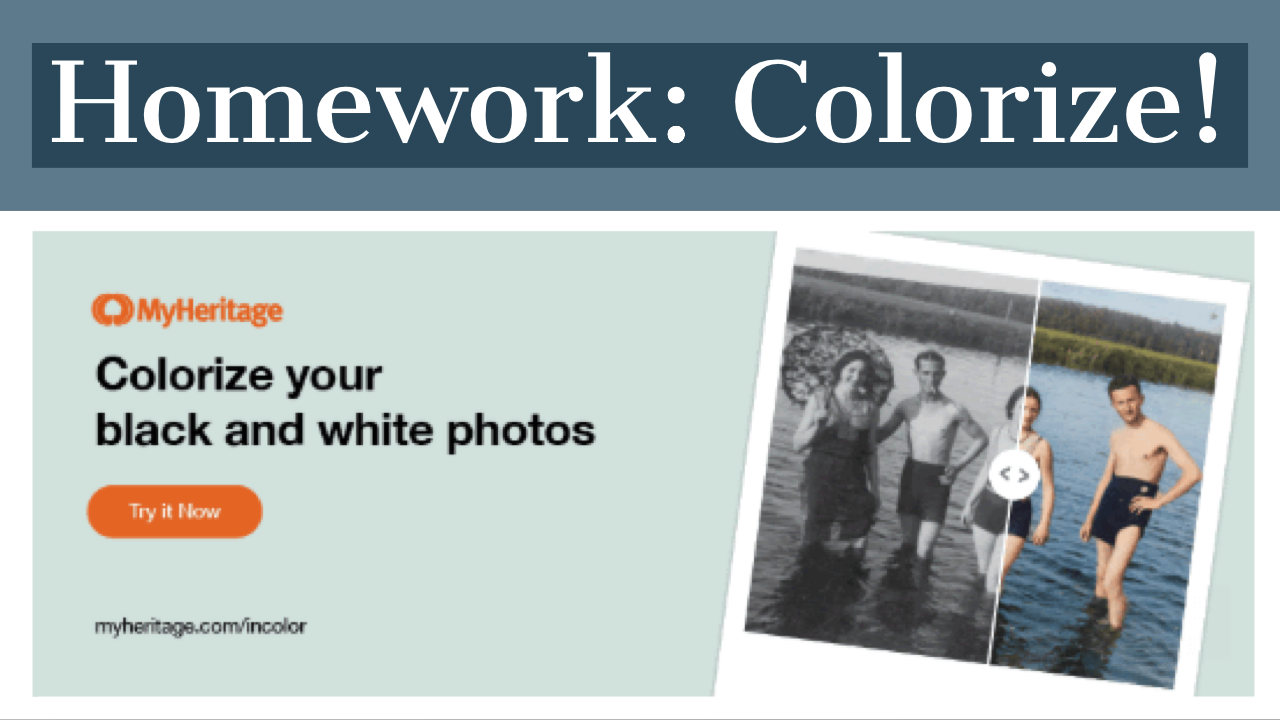
Enjoy Free and Unlimited Access to MyHeritage In Color™
We got some happy news during this time of self-quarantine. MyHeritage is granting free access to MyHeritage In Color™ through April 23, 2020.
Colorizing Old Family Photos
I shared this new service with you recently here on the Genealogy Gems blog, along with an example of the lovely work it did with one of my own old family photos.
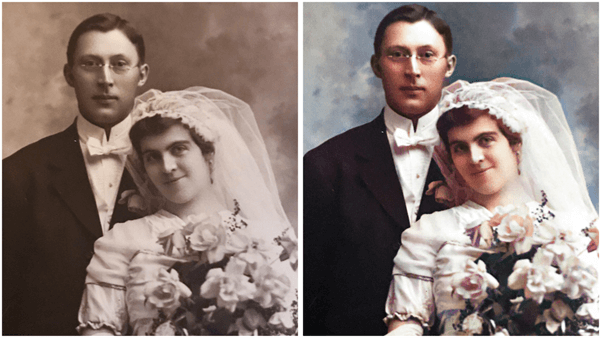
Eddie Larson and his wife colorized.
Read the post to learn more about using the service: MyHeritage Launches Colorized Photos!
Details on the Free Access
Here are the details on the free access and some exciting prize drawings from my friend Daniel Horowitz, Genealogy Expert at MyHeritage:
I’m happy to share that we’re giving everyone FREE and unlimited access to MyHeritage In Color™ from March 23 to April 23, so that people everywhere can join in the fun of colorizing their black and white photos.
Ordinarily only 10 photos can be colorized by users who do not have a Complete plan, but now, you can colorize as many photos as you’d like for free.

Colorizing photos is the perfect activity for anyone who is isolated at home. We invite everyone to pull out their family photo albums, colorize their photos, and start reminiscing.
Enter the Drawing
Over the coming month, anyone who shares their colorized photos on Twitter, Facebook, or Instagram with the hashtag #ColorBeatsCoronavirusBlues and tags @MyHeritage will enter a weekly draw. Each week we’ll select one lucky winner who will receive a free MyHeritage Complete subscription!





